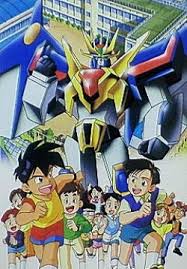The fifth-dimensional Jaku Empire (literally, “the Evil Empire”) has decided to conquer the third dimension, starting with Earth. Good thing Earth has a powerful guardian spirit named Eldoran. Or perhaps we should say had a powerful guardian spirit, as Eldoran blocks the invaders’ one-shot superweapon at the cost of crippling himself to a near-death state.
Eldoran has a back-up plan. He bestows the remainder of his power, in the form of giant robots that combine into larger giant robots, on a class of fifth-graders who are in school on Saturday doing make-up work. The military isn’t too thrilled with the fact that the world’s fate is in the hands of a bunch of pre-teens, but the Earth Defense Class is the only ones who can use the mighty Raijin-Oh against the weekly monster attacks.
Zettai Muteki Raijin-Oh was a 1991 anime series for children, the first of the “Eldoran Trilogy.” It falls into the “super robot” subgenre of the mecha genre, which means that it generally ignores questions of practicality and treats the laws of physics as mild suggestions. (As opposed to the “real robot” subgenre where they at least handwave explanations as to how the mecha work in realistic terms.)
There are eighteen kids in Class 5-3, nine boys and nine girls of varied size, shape, social status and personality, so it’s easy for most viewers to have a favorite. And all of them are important. Sure, some of them get much more screen time, but even if your job is just to pull the transformation lever, no one else can do that, so if you go missing, the team will lose.
The kids who get the most screentime are:
- Jin, the pilot of Ken-Oh, a swordsman mecha, and lead pilot of Raijin-Oh when the robots combine. He’s a typical boys’ anime lead, spiky-haired, hot-blooded and book-dumb.
- Asuka, the pilot of Hou-Oh, a bird mecha. He’s a handsome and diplomatic lad, and a hit with the girls. Asuka likes being treated well because of his looks, but doesn’t really grok why being liked by women is a thing.
- Kouji, the pilot of Juu-Oh, a lion mecha. He’s a dreamer and UFO nut, who’s a bit timid, but is better at understanding people than his two buddies.
- Maria, the class leader. She’s an all-rounder who’s good but not the best at many skills, and coordinates the Command Center when monsters attack. Her only flaw is a bit of a temper, mostly caused by Jin’s antics. (The series is clearly setting Jin and Maria up for a romance in their teens.)
- Tsutomu, the class nerd. He’s the one who handles technical issues and discovering new powers for the robots.
While the adults are shut out of being able to save the day, Mr. Shinoda (the homeroom teacher), Miss Himeji (school nurse) and the Principal (who is skilled in kung fu) often are able to help the kids out with real-world problems. Even the General eventually is a bit helpful, though he never completely warms up to the notion that military might is not the answer.
Over on the villain side, the leader is Belzeb, who is literally heartless. Instead, he has an evil fairy named Falzeb living in his rib cage. He’s assisted by the bumbling Taida, a chubby, childish fellow who isn’t really cut out for the villain lifestyle. The monsters start out as akudama (“evil balls”), round bits of darkness that are scattered around the landscape. When activated by the word meiwaku (“troublesome”, “annoying” , “problematic”) then turn into a small monster that takes its theme from whatever was described with the code word.
Thus we have things like a pollution monster, a flu monster, a superhero monster (that one had some serious “which side am I on?” issues) and so forth. At some point, Falzeb would energize the monster, turning it into a larger, more powerful version, and Raijin-Oh would need to fight it.
The plots do tend to be formulaic. One of the children has a spotlight subplot, such as being afraid of dogs. The monster may or may not relate to that subplot, but generally defeating the monster will also resolve the subplot. There’s plenty of stock footage of the various uniform changes, robot launches and transformations and special attacks. One episode about halfway through is a clip show, though it does answer a few pertinent questions. (The robots combining to form Raijin-Oh takes less than three seconds real time, not the over a minute it looks like in the stock footage.)
Some of the spotlight episodes are more disappointing for fans of those individual characters, as Jin has his own secondary subplot, meaning that the character whose spotlight it is gets even less time.
The series is being brought to the U.S. by Anime Midstream, a small independent company formed for the purpose. They’ve titled it Matchless Raijin-Oh and five volumes are currently available on DVD. The disks have both subtitled and dubbed versions, with the dub being done mostly by enthusiastic amateurs. (It’s okay, but not quite up to professional standards.)
The series is kid-friendly, but parents should be aware that Japan has different standards for how much nudity is acceptable for children (we see a couple of naked butts in a non-sexual context) and some old-fashioned ideas about physical discipline of children are on display. (Jin’s parents especially believe in the usefulness of a good smack to the head.) The blooper reels are less kid-friendly; the worst words are bleeped out, but parental no-nos are still heard.
If your kids already enjoy loud exciting action cartoons, please consider supporting this small business. Older anime fans may find it a bit childish, but there’s still plenty to love.


1 comment
Comments are closed.